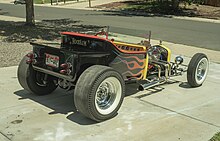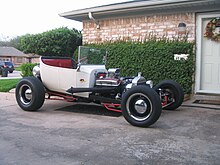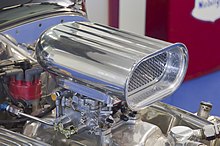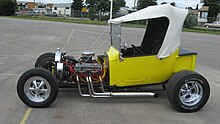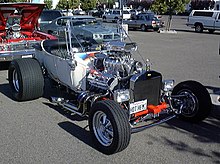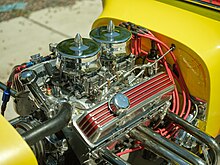
The Ford Model T is an automobile that was produced by the Ford Motor Company from October 1, 1908, to May 26, 1927. It is generally regarded as the first mass-affordable automobile, which made car travel available to middle-class Americans. The relatively low price was partly the result of Ford's efficient fabrication, including assembly line production instead of individual handcrafting. The savings from mass production allowed the price to decline from $780 in 1910 to $290 in 1924. It was mainly designed by three engineers, Joseph A. Galamb, Eugene Farkas, and Childe Harold Wills. The Model T was colloquially known as the "Tin Lizzie".

The Lamborghini Diablo is a high-performance mid-engine sports car built by Italian automobile manufacturer Lamborghini between 1990 and 2001. It is the first production Lamborghini capable of attaining a top speed in excess of 320 kilometres per hour (200 mph). After the end of its production run in 2001, the Diablo was replaced by the Lamborghini Murciélago. The name Diablo means "devil" in Spanish.

The Firenza is a model of car offered by Vauxhall from May 1971 until 1975. It was a development of the Viva, but had a distinctive coupé body style (fastback) and only two doors. In South Africa, it was sold as the Chevrolet Firenza until it was replaced by the Chevrolet 1300/1900 during 1975. Its name is derived from Firenze, the name of the Italian city known in English as Florence.

The AC Cobra, sold in the United States as the Shelby Cobra and AC Shelby Cobra, is a sports car manufactured by British company AC Cars, with a Ford V8 engine. It was produced intermittently in both the United Kingdom and later the United States since 1962.

Funny Car is a type of drag racing vehicle and a specific racing class in organized drag racing. Funny cars are characterized by having tilt-up fiberglass or carbon fiber automotive bodies over a custom-fabricated chassis, giving them an appearance vaguely approximating manufacturers' showroom models. They also have the engine placed in front of the driver, as opposed to dragsters, which place it behind the driver.

The term 1932 Ford may refer to three models of automobile produced by Ford Motors between 1932 and 1934: the Model B, the Model 18, and the Model 40. These succeeded the Model A. The Model B had an updated four-cylinder engine and was available from 1932 to 1934. The V8 was available in the Model 18 in 1932, and in the Model 40 in 1933 & 1934. The 18 was the first Ford fitted with the flathead V-8. The company also replaced the Model AA truck with the Model BB, available with either the four- or eight-cylinder engine.
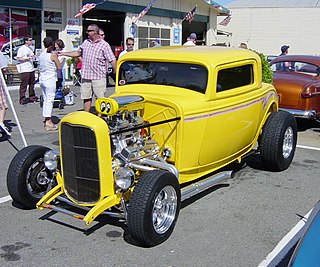
Hot rods are typically American cars that might be old, classic, or modern and that have been rebuilt or modified with large engines optimized for speed and acceleration. One definition is: "a car that's been stripped down, souped up and made to go much faster." However, there is no definition of the term that is universally accepted and the term is attached to a wide range of vehicles. Most often they are individually designed and constructed using components from many makes of old or new cars, and are most prevalent in the United States and Canada. Many are intended for exhibition rather than for racing or everyday driving.

A Baja Bug is an original Volkswagen Beetle modified to operate off-road, although other versions of air-cooled Volkswagens are sometimes modified as well. Baja bugs often race in off road desert races such as the Baja 1000. There are different classes for bugs, namely class 11, class 5 1600, and class 5 unlimited. According to desert racing association Score International, class 11 is a stock VW beetle with modifications limited to ground clearance and strength. Class 5 1600 rules state that a 1600 cc VW engine must be used and the car must have the exterior appearance of a "baja bug" with body modification limited to whatever cutting is needed to install a consumer baja kit. Class 5 unlimited is any 4 cylinder VW-style engine, and it must have Baja-style fenders and side panels, and VW-style suspension.

The Ferrari 275 is a series of front-engined V12-powered grand touring automobiles with two-seater coupé and spider bodies produced by Ferrari between 1964 and 1968. The first 275 series cars were powered by a 3.3 L (3286 cc) overhead camshaft Colombo 60° V12 engine producing 260–320 hp (190–240 kW). An updated 275 GTB/4 was introduced in 1966, with a revised four overhead camshaft engine producing 300 hp (220 kW). The 275 series were the first road-going Ferraris equipped with a transaxle and independent rear suspension.
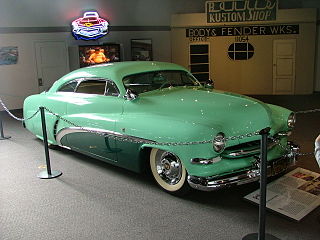
A custom car is a passenger vehicle that has been altered to either improve its performance, change its aesthetics, or a combination of both. A desire among some automotive enthusiasts in the United States is to push "styling and performance a step beyond the showroom floor - to truly craft an automobile of one's own." A custom car in British according to Collins English Dictionary is built to the buyer's own specifications.

The Chevrolet Corvette (C2) is the second generation of the Corvette sports car, produced by the Chevrolet division of General Motors (GM) for the 1963 through 1967 model years.
Dean Moon was an American automobile designer. He grew up in Norwalk, California. Moon was around cars and racing from his youth. His father owned "Moon Café" and had a go-kart track he called "Moonza", a pun on Monza. Dean was involved in dry lakes hot-rodding in the late 1940s. He founded MOON Speed Equipment (c.1950) and worked to improve the quality and safety of speed and racing products his entire life.

Norman "Norm" Grabowski was a Polish- American hot rod builder and actor. The heavy-set crew cut-wearing Grabowski appeared in minor roles in many films produced by Albert Zugsmith and Walt Disney.
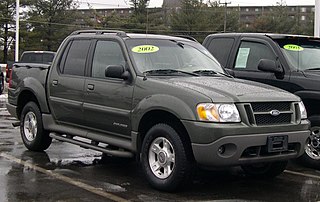
A nerf bar is a tubular device fitted to the side of a racecar, typically single-seat race cars that compete on asphalt or dirt oval tracks. A "nerf" is a small, sometimes intentional, collision between two cars in which one driver bumps the other to facilitate a successful pass. The nerf bar protects the sides of the vehicles and also keeps their tires from becoming entangled. If fast-spinning tires come in contact with each other, one or both of the cars may lose control or even become airborne. These are commonly used on Modifieds such as used in the NASCAR Whelen Modified Series, and the wheel pods behind the rear wheels on a Dallara DW12 INDYCAR is often nicknamed the nerf bar because of the similar purpose.

Devin Enterprises was an American automotive manufacturer that operated from 1955 to 1964. Devin was mainly known for producing high quality fiberglass car bodies that were sold as kits, but they also produced automotive accessories as well as complete automobiles. The company was founded by Bill Devin.

The Bill Thomas Cheetah was an American sports car designed and engineered entirely with American components, and built from 1963 to 1966 by Chevrolet performance tuner Bill Thomas. It was developed as a competitor to Carroll Shelby's Cobra.

The Ford Fairlane Thunderbolt is a limited production, factory experimental, drag racing version of the Ford Fairlane produced during the 1964 model year only. A total of 100 units were produced; forty-nine 4-speeds and fifty-one automatics, enough to secure the 1964 NHRA Super Stock championship for Ford.
A car song is a song with lyrics or musical themes pertaining to car travel. Though the earliest forms appeared in the 1900s, car songs emerged in full during the 1950s as part of rock and roll and car culture, but achieved their peak popularity in the West Coast of the United States during the 1960s with the emergence of hot rod rock as an outgrowth of the surf music scene. Though this popularity declined by the late 1960s, cars remain a frequently used subject matter in pop music into the 21st century.

G.T.O. is the debut studio album by American band Ronny & the Daytonas, and was released in 1964 on Mala Records, MALA 4001.
Silhouette was an award-winning show car built by Bill Cushenbery in 1962. It debuted at the 1963 Oakland Roadster Show.
